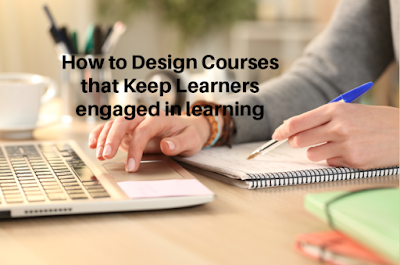How to Design Courses that Keep Learners engaged in learning
A common perception is that online courses require students to simply read or see videos, and then regurgitate the data in a composition or easy discussion article. Nonetheless, this is false as there are various actions that fully engage online students. Teaching at a totally online environment can be daunting even for experienced online instructors when they must prep a new course. However, with a few simple strategies, the procedure can be smooth and enjoyable. Here are four strategies which any instructor can use to successfully build an internet course.
1. Involve the Learner
Students should demonstrate their understanding of the content as well as enhance their involvement with the content throughout any program. Instructors can incorporate authentic tasks that connect real-world relevance and content comprehension. Authentic activities can vary from analyzing case studies to generating problem-based situations in which the students investigate the issue and create solutions or speech gaps inside the issue.
Instructors also can utilize inquiry-based learning (IBL), which requires pupils to research questions that they have regarding the material. Using KWL charts can initiate exploration of the content as pupils identify what they know and what they wish to learn more about the subject.
Inquiry starts when pupils explore areas they're not familiar with and create questions to direct them in this exploration. A final project based on their questions in the KWL chart will guide their learning. But before students begin their final job, they ought to submit a proposal to the teacher on how they are going to present the content learned so as to ensure content attention. Last projects can range from, but not limited to, research, scholarly or implemented, extensive discussion-based job playing and enactment of practice. You can also opt for online cloud training.
2. Choose culturally relevant materials.
According to the National Council of Teachers of English, students who don't find representations of their own cultures in texts are more likely to lose interest in school-based literacies. Take your students complete a short survey on their outside interests and use that information to assist in building your lesson plans. This will enable your students see the connections between what they're learning inside and outside the classroom.
3. Make Collaboration Work
After incorporating student participation in the class and with the teacher, the next thing is to increase cooperation between peers. Oftentimes, instructors think that cooperation in an online environment is hard or near hopeless.
Teachers can assign roles inside the PLC to aid with active involvement of students. Roles may include facilitator (functions as team leader and key touch to teacher ), interpreter (reteaches theories ), deadline (reiterates assignment standards and deadlines) and mentor (review's peer job and also provides professional review before admission ). PLCs are helpful for cooperation with real activities and helping with peer scaffolding to encourage students that are reluctant to engage.
If teachers prefer using group missions not connected with PLCs, then they ought to offer clearly defined expectations. Before beginning the mission, classes must determine who will manage what characteristics of this mission and signal when each element will be finished.
4. Use specific examples that are routine.
A simple method to help pupils feel connected to what they are being educated is to discuss how they could use the material in actual life.
The course's appearance can be intentionally tempting, intentionally disinviting, unwittingly inviting or unintentionally. Oftentimes teachers have a great deal of information which must be crammed to the online learning environment, which may make a disinviting learning atmosphere. To be able to make an intentionally inviting internet surroundings, classes have to get a very clear and consistent structure that provides intuitive navigation. Each module needs to have exactly the identical structure. Instead of reading materials, assignments, jobs, collaborative opportunities, etc.. constantly should be in exactly the exact same format and location.
Additionally, each module must look like the preceding modules, together with updated material and learning results. When thinking about one to one online learning class design and usability to students, an effective strategy is to make sure all resources used through the course are included inside the LMS.
The class layout can play a massive part in student and usability achievement. Microlearning involves introducing content via mediated micro degrees so students are vulnerable to little learning components on short-term missions. Microlearning relies on H.A. Simon's 1974 study that summarizes the potency of producing chunks of learning adventures which the short-term memory may sustain. This strategy translates into online course development via the utilization of learning modules.
After incorporating student participation in the class and with the teacher, the next thing is to increase cooperation between peers. Oftentimes, instructors think that cooperation in an online environment is hard or near hopeless.
Teachers can assign roles inside the PLC to aid with active involvement of students. Roles may include facilitator (functions as team leader and primary contact to teacher ), interpreter (reteaches theories ), deadline (reiterates mission criteria and deadlines) and mentor (review's peer work and also provides specialist review before admission ). PLCs are helpful for cooperation with real activities and helping with peer scaffolding to encourage students that are reluctant to engage.
If teachers prefer using group missions not connected with PLCs, then they ought to offer clearly defined expectations. Before beginning the mission, classes must determine who will manage what characteristics of the mission and indicate if each element will be finished.
A simple method to help pupils feel connected to what they are being educated is to discuss how they could use the material in actual life.
Oftentimes teachers have a great deal of information which must be crammed to the online learning environment, which may make a disinviting learning atmosphere. To be able to make an intentionally inviting internet surroundings, classes will need to get a very clear and consistent structure that provides intuitive navigation. Each module needs to have exactly the identical structure. Instead of studying materials, assignments, jobs, collaborative opportunities, etc.. constantly should be in precisely the exact same format and location.
Additionally, each module must look like the preceding modules, together with updated material and learning results. When thinking about class design and usability to students, an effective strategy is to make sure all resources used through the course are included inside the LMS.
The class layout can play a massive part in student and usability achievement. Microlearning involves introducing content via mediated micro degrees so students are vulnerable to little learning components on short-term missions. Microlearning relies on H.A. Simon's 1974 study that summarizes the potency of producing chunks of learning adventures the short-term memory may sustain. This strategy translates into online course development via the utilization of learning modules.
More courses you may like:
developing on aws online course
data warehousing on aws training



Comments
Post a Comment